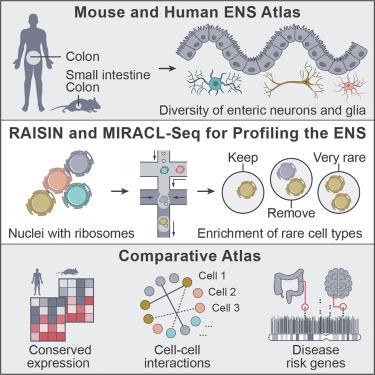Cell ( IF 45.5 ) Pub Date : 2020-09-03 , DOI: 10.1016/j.cell.2020.08.003 Eugene Drokhlyansky 1 , Christopher S Smillie 1 , Nicholas Van Wittenberghe 1 , Maria Ericsson 2 , Gabriel K Griffin 3 , Gokcen Eraslan 1 , Danielle Dionne 1 , Michael S Cuoco 1 , Max N Goder-Reiser 4 , Tatyana Sharova 4 , Olena Kuksenko 1 , Andrew J Aguirre 5 , Genevieve M Boland 6 , Daniel Graham 7 , Orit Rozenblatt-Rosen 1 , Ramnik J Xavier 8 , Aviv Regev 9

|
The enteric nervous system (ENS) coordinates diverse functions in the intestine but has eluded comprehensive molecular characterization because of the rarity and diversity of cells. Here we develop two methods to profile the ENS of adult mice and humans at single-cell resolution: RAISIN RNA-seq for profiling intact nuclei with ribosome-bound mRNA and MIRACL-seq for label-free enrichment of rare cell types by droplet-based profiling. The 1,187,535 nuclei in our mouse atlas include 5,068 neurons from the ileum and colon, revealing extraordinary neuron diversity. We highlight circadian expression changes in enteric neurons, show that disease-related genes are dysregulated with aging, and identify differences between the ileum and proximal/distal colon. In humans, we profile 436,202 nuclei, recovering 1,445 neurons, and identify conserved and species-specific transcriptional programs and putative neuro-epithelial, neuro-stromal, and neuro-immune interactions. The human ENS expresses risk genes for neuropathic, inflammatory, and extra-intestinal diseases, suggesting neuronal contributions to disease.
中文翻译:

单细胞分辨率的人类和小鼠肠神经系统。
肠神经系统(ENS)协调肠道内的多种功能,但由于细胞的稀有性和多样性,未能进行全面的分子表征。在这里,我们开发了两种方法以单细胞分辨率分析成年小鼠和人类的 ENS:RAISIN RNA-seq 用于分析带有核糖体结合 mRNA 的完整细胞核,而 MIRACL-seq 用于通过基于液滴的方法对稀有细胞类型进行无标记富集分析。我们的小鼠图谱中的 1,187,535 个细胞核包括来自回肠和结肠的 5,068 个神经元,揭示了非凡的神经元多样性。我们强调了肠神经元的昼夜节律表达变化,表明疾病相关基因随着衰老而失调,并确定了回肠和近端/远端结肠之间的差异。在人类中,我们分析了 436,202 个细胞核,恢复了 1,445 个神经元,并鉴定了保守的和物种特异性的转录程序以及假定的神经上皮、神经基质和神经免疫相互作用。人类 ENS 表达神经病、炎症和肠外疾病的风险基因,表明神经元对疾病有贡献。











































 京公网安备 11010802027423号
京公网安备 11010802027423号